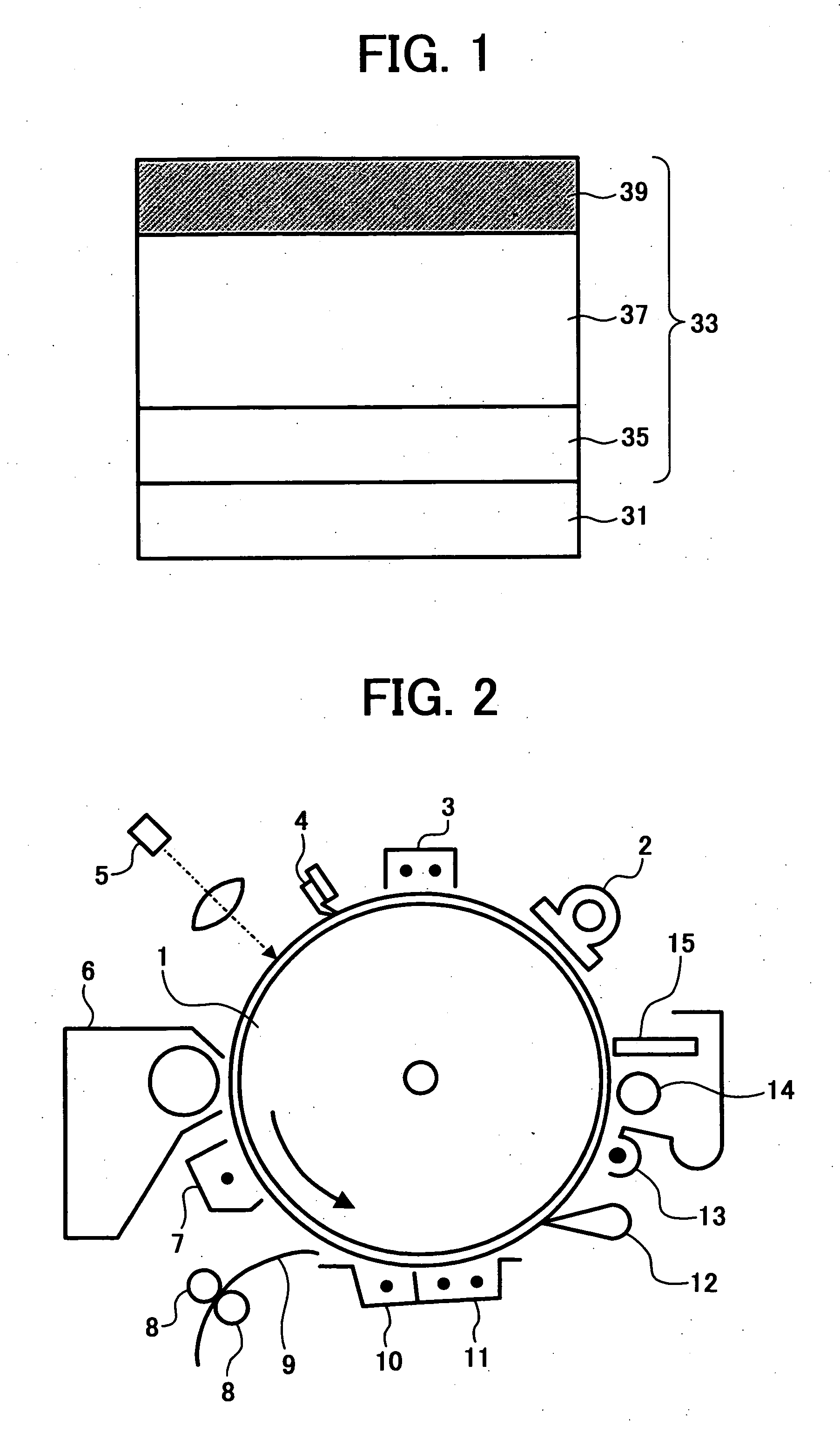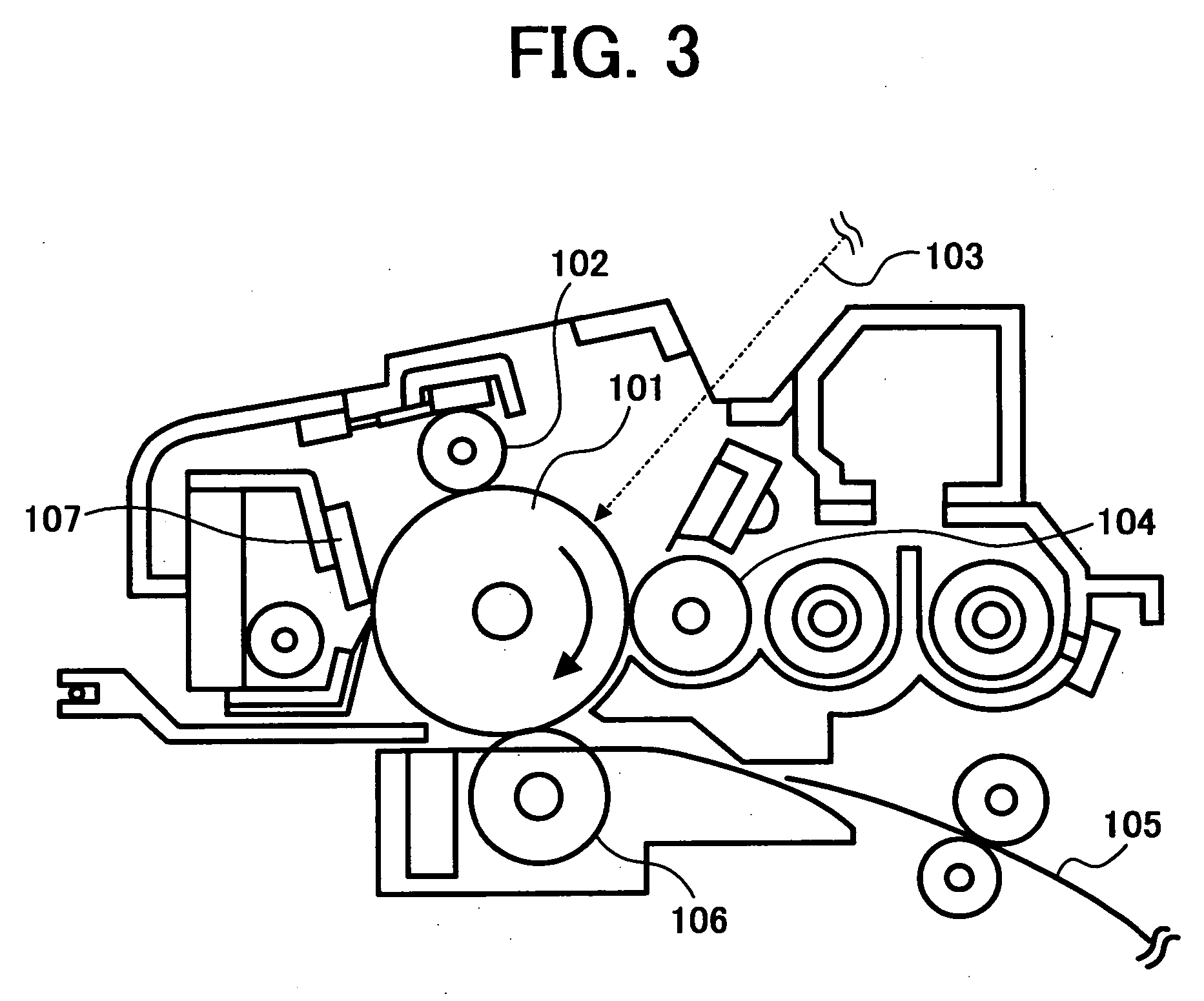Electrophotographic photoreceptor, and image forming method, image forming apparatus and process cartridge therefor using the electrophotographic photoreceptor
an electrophotographic and photoreceptor technology, applied in the field of electrophotographic photoreceptors, can solve the problems of abnormal images such as image density deterioration and background fouling, and the mechanical ablation of organic photoreceptors, and achieve the effect of good abrasion resistance and electrical properties, and less white-spotted defective images
- Summary
- Abstract
- Description
- Claims
- Application Information
AI Technical Summary
Benefits of technology
Problems solved by technology
Method used
Image
Examples
preparation example 1
OF CONSTITUENT (A)
Preparation of 4,4′-dimethyltriphenylamine
[0156] 18.63 g of aniline from TOKYO KASEI KOGYO Co., Ltd., 89.39 g of p-iodinetoluene, 66.34 g of kalium carbonate and 1.27 g of copper powder were mixed in a reaction reservoir having a mixer, a thermometer and a cooling pipe, and the mixture was subjected to a reaction at 210° C. for 25 hrs. The reacted liquid was diluted with 200 ml of cyclohexane after cooled, subjected to an absorption treatment with an active clay and silica gel, and condensed to prepare 29.82 g of a crystal of 4,4′-dimethyltriphenylamine, having a melting point of 109° C.
Preparation of 4-bromo-4′,4″-dimethyltriphenylamine
[0157] 14.53 g of 4,4′-dimethyltriphenylamine and 30 ml of dioxane were put in a reaction reservoir having a mixer, a thermometer and a dropping funnel, a liquid prepared by slowly dropping 9.34 g of bromine into 50 ml of dioxane at a room temperature was slowly dropped therein at a room temperature under a nitrogen stream, and f...
preparation example 2
OF CONSTITUENT (A)
Synthesis of a Mixture of the Exemplified Compound No. 2 and a Compound Having the Following Formula (13)
[0172]
[0173] The procedure for preparation of the exemplified compound No. 2 was repeated except for using 3 g of a mixture of the 2-hydroxy-3-(4-(4′-N,N-di-p-tolylamino)biphenyloxy)propylmethacrylate and 2-hydroxymethyl-2-(4-(4′-N,N-di-p-tolylamino)biphenyloxy)ethylmethacrylate to prepare 2.86 g of an achromatic oil mixture.
[0174] IR measurement data thereof are shown in FIG. 7.
[0175] The achromatic oil mixture had a positively-determined mass value of 562 per unit charge in accordance with the molecular weight +1 (proton addition) when ionized by an atmospheric pressure chemical ionization method.
preparation example 3
OF CONSTITUENT (A)
Synthesis of a Compound Having the Following Formula (14)
[0176]
Preparation of 1,2-dihydroxy-3-(4-(4′-N,N-di-p-tolylamino)biphenyloxy)propane
[0177] 5.0 g of 4-hydroxy-4′-N,N-di-p-tolylaminobiphenyl, an aqueous solution including 1.8 g of sodium hydrate an 8 g of water and 30 ml of tetrahydrofuran were mixed in a reaction reservoir having a mixer, a thermometer, cooling pipe and a dropping funnel, and a solution of 1.9 ml of glycidylmethacrylate and 10 ml of tetrahydrofuran was dropped in the mixture at a room temperature under a nitrogen stream. Then, the mixture was subjected to a reaction at 50° C. for 10 hrs.
[0178] Then, the mixture was diluted with ethylacetate, and washed with water and solvents were removed therefrom to prepare 7 g of a crude material. The crude material was refined by column chromatography using silica gel and a solvent including ethylacetate to prepare 4 g of an achromatic crystal of 1,2-dihydroxy-3-(4-(4′-N,N-di-p-tolylamino)biphenyloxy)...
PUM
 Login to View More
Login to View More Abstract
Description
Claims
Application Information
 Login to View More
Login to View More - R&D
- Intellectual Property
- Life Sciences
- Materials
- Tech Scout
- Unparalleled Data Quality
- Higher Quality Content
- 60% Fewer Hallucinations
Browse by: Latest US Patents, China's latest patents, Technical Efficacy Thesaurus, Application Domain, Technology Topic, Popular Technical Reports.
© 2025 PatSnap. All rights reserved.Legal|Privacy policy|Modern Slavery Act Transparency Statement|Sitemap|About US| Contact US: help@patsnap.com



